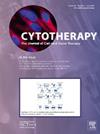SUCCESSFUL REDIRECTION OF TCR SPECIFICITY AGAINST CRYPTIC LEUKEMIA ANTIGENS USING NON-VIRAL TCR ENGINEERING
IF 3.7
3区 医学
Q2 BIOTECHNOLOGY & APPLIED MICROBIOLOGY
引用次数: 0
Abstract
Background & Aim
Acute myeloid leukemia (AML) remains highly lethal despite significant treatment advances, with a high relapse rate and an urgent need for novel therapies. The discovery and characterization of new antigenic targets capable of eliciting therapeutic responses remain critical to treating more patients. Leukemia cells can express tumor-specific antigens (TSA) absent in healthy tissues. Proteogenomic analysis have identified several MHC Class I-associated peptides eluted from AML cells that are derived from extra-exomic regions of the genome and selectively expressed in AML. These cryptic antigens present as promising targets for immunotherapy, prompting us to characterize T-cell responses against them and develop a T-cell receptor (TCR) transgenic strategy for clinical application.
Methodology
Using synthesized peptides, we generated cryptic TSA-specific CD8+ T cell lines by co-culturing healthy donor T cells with autologous dendritic cells presenting the peptide of interest. Antigen-specific T cells were identified via cytokine secretion assays and fluorescent MHC-peptide multimers. Sorted multimer-positive T cells underwent RNA 5’RACE PCR to amplify their TCR alpha and beta chains. These were cloned into a nanoplasmid and inserted in situ into the TRAC locus of the endogenous TCR via single-step TCR replacement using CRISPR-Cas9, ensuring deletion of native TCR chains. Antigenic redirection was confirmed through cytokine secretion after exposure to cryptic TSA peptide and cytotoxicity assay.
Results
After establishing that cryptic TSAs were recognized by T cells in healthy donors' peripheral blood, we demonstrated that at least 60% (6/10) of tested peptides were antigenic. T-cell responses were highly oligoclonal, and as few clonotypes were present among antigen-specific cells, alpha and beta chain pairing following 5’RACE PCR was facilitated. Assessment of CD3 and TCR expression using flow cytometry confirmed successful TCR replacement. Functional assays, including ELISpot, cytokine secretion, and cytotoxicity assays, confirmed that these engineered TCRs could redirect T cells' antigenic specificity towards the recognition of cryptic leukemia antigens.
Conclusion
Ex vivo expansion of cryptic antigen-specific T cells enables TCR identification that can be used to devise new T-cell immunotherapies through TCR engineering. This strategy allows the generation of large numbers of AML-specific, reactive T lymphocytes towards cryptic TSA, offering promising new therapeutic avenues.
利用非病毒TCR工程成功重定向TCR对隐性白血病抗原的特异性
背景,急性髓系白血病(AML)尽管治疗取得了重大进展,但仍具有高致死率,复发率高,迫切需要新的治疗方法。能够引发治疗反应的新抗原靶点的发现和表征仍然是治疗更多患者的关键。白血病细胞可以表达健康组织中不存在的肿瘤特异性抗原(TSA)。蛋白质基因组学分析已经确定了从AML细胞中洗脱的几种MHC i类相关肽,这些肽来源于基因组的外显子组区域,并在AML中选择性表达。这些隐性抗原作为免疫治疗的有希望的靶点,促使我们表征t细胞对它们的反应,并开发用于临床应用的t细胞受体(TCR)转基因策略。方法:利用合成的多肽,通过将健康供体T细胞与呈递目标多肽的自体树突状细胞共培养,生成tsa特异性CD8+ T细胞系。抗原特异性T细胞通过细胞因子分泌测定和荧光mhc肽多聚体鉴定。对分选的多阳性T细胞进行RNA 5′race PCR扩增其TCR α链和β链。它们被克隆到纳米质粒中,通过CRISPR-Cas9单步TCR替换,原位插入内源性TCR的TRAC位点,确保原生TCR链的缺失。暴露于隐TSA肽和细胞毒性试验后,通过细胞因子分泌证实抗原重定向。结果在确定了隐藏性tsa能被健康供者外周血中的T细胞识别后,我们证明了至少60%(6/10)的测试肽是抗原性的。t细胞反应是高度寡克隆的,由于抗原特异性细胞中存在很少的克隆型,因此促进了5'RACE PCR后的α链和β链配对。流式细胞术检测CD3和TCR表达,证实TCR置换成功。包括ELISpot、细胞因子分泌和细胞毒性试验在内的功能试验证实,这些工程化的TCRs可以将T细胞的抗原特异性转向对隐性白血病抗原的识别。结论体外扩增的隐抗原特异性T细胞可用于TCR鉴定,并可通过TCR工程设计新的T细胞免疫疗法。这一策略允许大量aml特异性反应性T淋巴细胞对隐性TSA产生,提供了有希望的新治疗途径。
本文章由计算机程序翻译,如有差异,请以英文原文为准。
求助全文
约1分钟内获得全文
求助全文
来源期刊

Cytotherapy
医学-生物工程与应用微生物
CiteScore
6.30
自引率
4.40%
发文量
683
审稿时长
49 days
期刊介绍:
The journal brings readers the latest developments in the fast moving field of cellular therapy in man. This includes cell therapy for cancer, immune disorders, inherited diseases, tissue repair and regenerative medicine. The journal covers the science, translational development and treatment with variety of cell types including hematopoietic stem cells, immune cells (dendritic cells, NK, cells, T cells, antigen presenting cells) mesenchymal stromal cells, adipose cells, nerve, muscle, vascular and endothelial cells, and induced pluripotential stem cells. We also welcome manuscripts on subcellular derivatives such as exosomes. A specific focus is on translational research that brings cell therapy to the clinic. Cytotherapy publishes original papers, reviews, position papers editorials, commentaries and letters to the editor. We welcome "Protocols in Cytotherapy" bringing standard operating procedure for production specific cell types for clinical use within the reach of the readership.
 求助内容:
求助内容: 应助结果提醒方式:
应助结果提醒方式:


